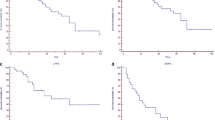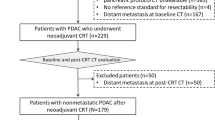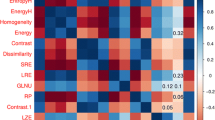Abstract
Purpose
Aim of this study is to assess the ability of contrast-enhanced CT image-based radiomic analysis to predict local response (LR) in a retrospective cohort of patients affected by pancreatic cancer and treated with stereotactic body radiation therapy (SBRT). Secondary aim is to evaluate progression free survival (PFS) and overall survival (OS) at long-term follow-up.
Methods
Contrast-enhanced-CT images of 37 patients who underwent SBRT were analyzed. Two clinical variables (BED, CTV volume), 27 radiomic features were included. LR was used as the outcome variable to build the predictive model. The Kaplan–Meier method was used to evaluate PFS and OS.
Results
Three variables were statistically correlated with the LR in the univariate analysis: Intensity Histogram (StdValue feature), Gray Level Cooccurrence Matrix (GLCM25_Correlation feature) and Neighbor Intensity Difference (NID25_Busyness feature). Multivariate model showed GLCM25_Correlation (P = 0.007) and NID25_Busyness (P = 0.03) as 2 independent predictive variables for LR. The odds ratio values of GLCM25_Correlation and NID25_Busyness were 0.07 (95%CI 0.01–0.49) and 8.10 (95%CI 1.20–54.40), respectively. The area under the curve for the multivariate logistic regressive model was 0.851 (95%CI 0.724–0.978). At a median follow-up of 30 months, median PFS was 7 months (95%CI 6-NA); median OS was 11 months (95%CI 10–22 months).
Conclusions
This analysis identified a radiomic signature that correlates with LR. To confirm these results, prospective studies could identify patient sub-groups with different rates of radiation dose–response to define a more personalized SBRT approach.




Similar content being viewed by others
References
Lockhart AC, Rothenberg ML, Berlin JD (2005) Treatment for pancreatic cancer: current therapy and continued progress. Gastroenterology 128(6):1642–1654
Li D, **e K, Wolff R, Abbruzzese JL (2004) Pancreatic cancer. Lancet 363(9414):1049–1057
Worni M, Guller U, White RR et al (2013) Modest improvement in overall survival for patients with metastatic pancreatic cancer: a trend analysis using the surveillance, epidemiology, and end results registry from 1988 to 2008. Pancreas 42:1157–1163
Brennan MF, Kattan MW, Klimstra D et al (2004) Prognostic nomogram for patients undergoing resection for adenocarcinoma of the pancreas. Ann Surg 240:293–298
Mazzola R, Corradini S, Gregucci F et al (2019) Role of radiosurgery/stereotactic radiotherapy in oligometastatic disease: brain oligometastases. Front Oncol 9:206
Meduri B, Gregucci F, D’Angelo E et al (2020) Volume de-escalation in radiation therapy: state of the art and new perspectives. J Cancer Res Clin Oncol 146(4):909–924
Gillies RJ, Kinahan PE, Hricak H (2016) Radiomics: images are more than pictures, they are data. Radiology 278(2):563–577
Macgregor-Das AM, Iacobuzio-Donahue CA (2013) Molecular pathways in pancreatic carcinogenesis. J Surg Oncol 107:8e14
Chu GC, Kimmelman AC, Hezel AF, DePinho RA (2007) Stromal biology of pancreatic cancer. J Cell Biochem 101:887–907
Neesse A, Krug S, Gress TM et al (2013) Emerging concepts in pancreatic cancer medicine: targeting the tumor stroma. Onco Targets Ther 7:33–43
Fisher R, Pusztai L, Swanton C (2013) Cancer heterogeneity: implications for targeted therapeutics. Br J Cancer 108:479–485
NCCN Clinical Practice Guidelines in Oncology (2020) Pancreatic adenocarcinoma. Version 2. http://www.nccn.org/professionals/ physician_gls/PDF/pancreatic.pdf. Accessed 1 May 2020.
Tamm EP, Balachandran A, Bhosale P, Szklaruk J (2009) Update on 3D and multiplanar MDCT in the assessment of biliary and pancreatic pathology. Abdom Imaging 34:64–74
Mazzola R, Fersino S, Gregucci F et al (2018) Linac-based stereotactic body radiation therapy for unresectable locally advanced pancreatic cancer: risk-adapted dose prescription and image-guided delivery. Strahlenther Onkol 194(9):835–842
Koay EJ, Truty MJ, Cristini V et al (2014) Transport properties of pancreatic cancer describe gemcitabine delivery and response. J Clin Invest 124(4):1525–1536
Farrell JJ, Elsaleh H, Garcia M et al (2009) Human equilibrative nucleoside transporter 1 levels predict response to gemcitabine in patients with pancreatic cancer. Gastroenterology 136(1):187–195
Hanania A, Bantis L, Feng Z et al (2016) Quantitative imaging to evaluate malignant potential of IPMNs. Oncotarget 7:85776–85784
Permuth J, Choi J, Balarunathan Y et al (2016) Combining radiomic features with a miRNA classifier may improve prediction of malignant pathology for pancreatic intraductal papillary mucinous neoplasms. Oncotarget 7:85785–85797
Chen X, Oshima K, Schott D et al (2017) Assessment of treatment response during chemoradiation therapy for pancreatic cancer based on quantitative radiomic analysis of daily CTs: an exploratory study. PlosOne 12:e0178961
Eilaghi A, Baig S, Zhang Y et al (2017) CT texture features are associated with overall survival in pancreatic ductal adenocarcinoma–a quantitative analysis. BMC Med Imaging 17:38
Cozzi L, Dinapoli N, Fogliata A et al (2017) Radiomics based analysis to predict local control and survival in hepatocellular carcinoma patients treated with volumetric modulated arc therapy. BMC Cancer 17:829
Cozzi L, Comito T, Fogliata A et al (2019) Computed tomography based radiomic signature as predictive of survival and local control after stereotactic body radiation therapy in pancreatic carcinoma. PLoS One 14(1):e0210758. https://doi.org/10.1371/journal.pone.0210758
Zhang L, Fried DV, Fave XJ et al (2015) IBEX: an open infrastructure software platform to facilitate collaborative work in radiomics. Med Phys 42(3):1341–1353
R Core Team (2018) R: A language and environment for statistical computing. R Foundation for Statistical Computing, Vienna, Austria. URL https://www.R-project.org/.
Nardone V, Reginelli A, Scala F et al (2019) Magnetic-resonance-imaging texture analysis predicts early progression in rectal cancer patients undergoing neoadjuvant chemoradiation. Gastroenterol Res Pract. 2019:8505798. https://doi.org/10.1155/2019/8505798
Castellano G, Bonilha L, Li LM et al (2004) Texture analysis of medical images. Clin Radiol 59(12):1061–1069
Neesse A, Pl M, Frese KK et al (2011) Stromal biology and therapy in pancreatic cancer. Gut 60:861–868
Kamisawa T, Wood LD, Itoi T et al (2016) Pancreatic cancer. Lancet 388:73–85
Herman JM, Chang DT, Goodman KA et al (2015) Phase 2 multi-institutional trial evaluating gemcitabine and stereotactic body radiotherapy for patients with locally advanced unresectable pancreatic adenocarcinoma. Cancer 121:1128–1137
Davnall F, Yip CS, Ljungqvist G et al (2012) Assessment of tumor heterogeneity: an emerging imaging tool for clinical practice? Insights Imaging 3(6):573–589
Yue Y, Osipov A, Fraass B et al (2016) Identifying prognostic intratumor heterogeneity using pre- and post-radiotherapy 18F-FDG PET images for pancreatic cancer patients. J Gastrointest Oncol 8:127–138
Mazzola R, Fersino S, Alongi P et al (2018) Stereotactic body radiation therapy for liver oligometastases: predictive factors of local response by 18 F-FDG-PET/CT. Br J Radiol 91(1088):20180058
Sollini M, Cozzi L, Antunovic L et al (2017) PET Radiomics in NSCLC: state of the art and a proposal for harmonization of methodology. Sci Rep 7:358
Funding
None.
Author information
Authors and Affiliations
Corresponding author
Ethics declarations
Conflict of interest
The authors declare that they have no conflict of interest.
Ethical approval
All procedures performed in studies involving human participants were in accordance with the ethical standards of the institutional and/or national research committee and with the 1964 Helsinki Declaration and its later amendments or comparable ethical standards.
Additional information
Publisher's Note
Springer Nature remains neutral with regard to jurisdictional claims in published maps and institutional affiliations.
Rights and permissions
About this article
Cite this article
Gregucci, F., Fiorentino, A., Mazzola, R. et al. Radiomic analysis to predict local response in locally advanced pancreatic cancer treated with stereotactic body radiation therapy. Radiol med 127, 100–107 (2022). https://doi.org/10.1007/s11547-021-01422-z
Received:
Accepted:
Published:
Issue Date:
DOI: https://doi.org/10.1007/s11547-021-01422-z




